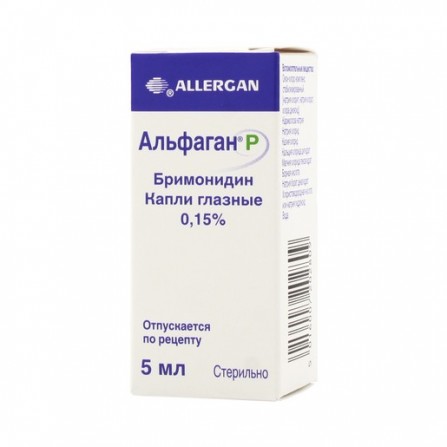Alphagan P eye drops 0.15% bottle dropper 5 ml
Condition: New product
1000 Items
Rating:
Be the first to write a review!

More info
Active ingredients
Brimonidine
Release form
Drops
Composition
1 ml contains: brimonidine tartrate 1.5 mg.
Pharmacological effect
Brimonidine is a selective α2-adrenomimetic that has a stimulating effect on α2-adrenergic receptors. When used in the form of eye drops 1.5 mg / ml, the maximum effect of reducing intraocular pressure (IOP) is achieved after 2 hours. The hypotensive effect of brimonidine is achieved by reducing the formation and increasing outflow of intraocular fluid along the uveoscleral tract.
Pharmacokinetics
When installing eye drops, Cmax in the blood plasma is reached in 0.5-2.5 hours, T1 / 2 is about 2 hours. Systemic absorption of brimonidine is slow. The drug is metabolized mainly in the liver. Brimonidine and its metabolites are excreted by the kidneys.
Indications
Open-angle glaucoma. Increased eye pressure (both monotherapy and in combination with other drugs that reduce IOP).
Contraindications
Hypersensitivity to brimonidine tartrate and other components Alphagan R. Simultaneous therapy with MAO inhibitors. During pregnancy and breastfeeding. Children's age up to 2 years, low body weight (up to 20 kg), since the safety and efficacy of the drug in these groups of patients has not been studied.
Use during pregnancy and lactation
Contraindicated.
Dosage and administration
Apply topically. Instill into the conjunctival sac of the affected eye 1 drop 3 times a day with an interval between administrations of 8 hours. Alphagan P can be used with other ophthalmologic drugs to reduce IOP. If the patient simultaneously uses other eye drops, it is necessary to adhere to an interval of at least 5 minutes between instillations.
Side effects
The frequency of side effects identified during the studies was assessed as follows: very often (more than 10%); often (more than 1% and less than 10%); infrequently (more than 0.1% and less than 1%); rarely (more than 0.01% and less than 0.1%). In clinical studies of the drug Alphagan P, the following side effects were identified: On the part of the organs of vision: very often - allergic conjunctivitis, hyperemia of the conjunctiva of the eyes, itching of the mucous membrane of the eyes and the eyelids; often - burning sensation, conjunctival folliculosis and follicular conjunctivitis,local allergic reactions of the mucous membrane of the eyes (including keratoconjunctivitis), blepharitis, blepharoconjunctivitis, impaired visual perception, cataracts, conjunctival edema, conjunctival hemorrhage, conjunctivitis, retentional lacrimation, eye exudations, and in order to be applied to the body, for example, in the case of the body, in case of the skin, hemorrhagic, conjunctival hemorrhage eyelid edema, eyelid redness, foreign body sensation in the eyes, keratitis, eyelid damage, photosensitivity, superficial spotted keratopathy, lacrimation, loss of visual field, functional defeat of the vitreous body, vitreous hemorrhage, floating opacities in the vitreous body and reduced visual acuity; infrequently - erosion of the cornea, barley. On the side of the CNS: often - headache, drowsiness, insomnia, dizziness. On the part of the cardiovascular system: often - increase in blood pressure; infrequently - decrease in blood pressure. From the side of the respiratory organs: often - bronchitis, cough, shortness of breath; infrequently - dry nasal mucosa, apnea. From the gastrointestinal tract: often - gastrointestinal disorders, dyspepsia, dryness of the oral mucosa. On the side of the skin and subcutaneous fat: often - rashes, infectious disease (chills and respiratory infection), rhinitis, sinusitis, including infectious. Laboratory parameters: often - hypercholesterolemia. Others: often - common allergic reactions, asthenia, fatigue; infrequently - change in taste sensations. Children noted: apnea, bradycardia, lowering blood pressure, hypothermia, muscle hypotonia. In addition, data on the following effects were obtained: On the part of the organs of vision: the frequency is unknown - iritis, miosis. On the CNS side: depression. side of the cardiovascular system: bradycardia, tachycardia. On the side of the gastrointestinal tract: nausea. On the side of the skin and subcutaneous fat: local skin reactions (erythema, pruritus, swelling of the face, rash and vasodilation of the eyelid skin vessels).
Overdose
There are no reports of drug overdose. In case of accidental ingestion of the drug, the following symptoms are possible: CNS depression, drowsiness, loss of consciousness, decrease in blood pressure, bradycardia, decrease in body temperature, skin cyanosis, apnea. If symptoms of overdose are identified, symptomatic therapy and control of the airway are necessary.
Interaction with other drugs
When using more than one local ophthalmic agent, drugs are used with an interval of 5 minutes. Despite the lack of special studies of drug interactions, the possibility of enhancing the effect of drugs that suppress the central nervous system (alcohol, barbiturates, opium derivatives, sedatives, general anesthetics) should be considered. Considering the ability of alpha-adrenomimetics to reduce blood pressure and heart rate, antihypertensive drugs and cardiac glycosides should be prescribed with caution. Due to the known decrease in the severity of the hypotensive effect of clonidine (alpha adrenomimetic) when used in combination with tricyclic antidepressants, it is possible to reduce the effectiveness of Alphagan P with concomitant treatment with tricyclic antidepressants. Precautions should be prescribed the drug Alphagan P with tricyclic antidepressants, which can affect the metabolism of amines and their distribution in the vascular bed.
special instructions
Despite the evidence of the insignificant effect of brimonidine tartrate on total blood pressure, it is necessary to use it with caution in patients with the following diseases: orthostatic hypotension, severe cardiovascular diseases accompanied by heart failure, cerebrovascular diseases leading to cerebral insufficiency, renal failure ( creatinine clearance less than 40 ml / min), liver failure, depression, Raynaud's syndrome, thromboangiitis obliterans. It is necessary to strictly control the condition of patients with the above conditions, with the deterioration of the patient's condition, it is necessary to stop taking the drug. Patients who wear soft contact lenses need to remove them before instillation of the drug. Contact lenses can be put on again after 15 minutes.




